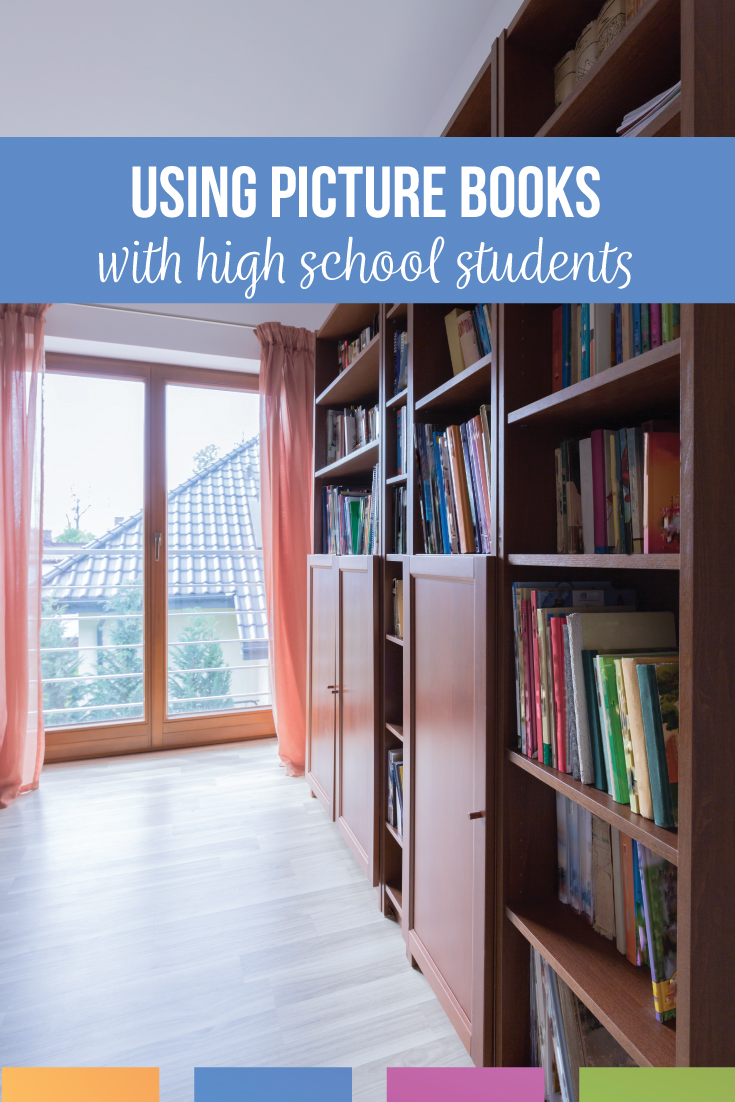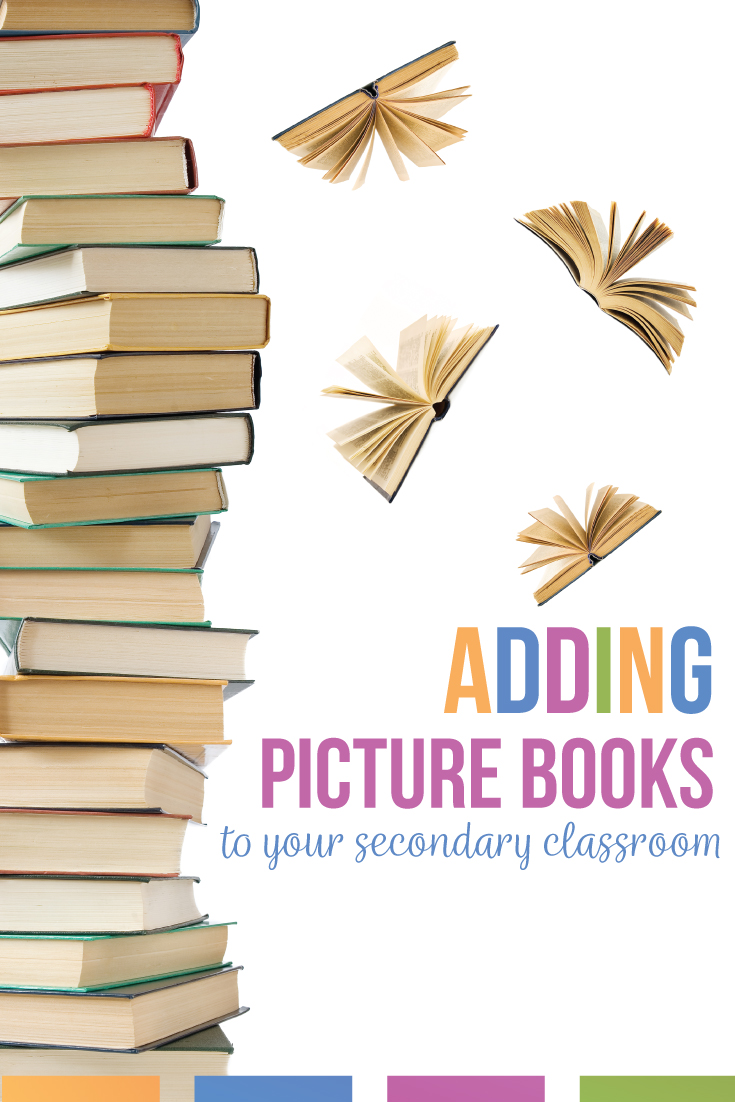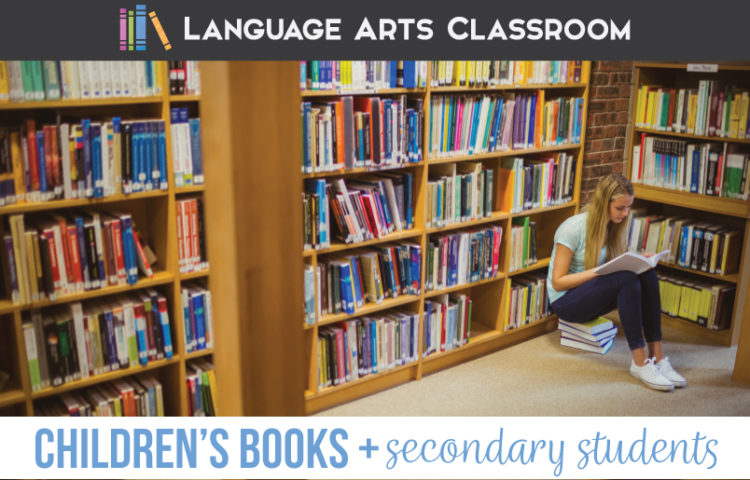Do you use picture books in the secondary classroom? My librarian calls these books “everybody books” and with good reason.
After I read The Book Whisperer, I knew that I wanted to expand my classroom library. I also realized that I needed a variety of books. I do not have a large budget, though. Then, I realized that picture books for high school students will be beneficial.

I’m the mother of three children, and we’ve accumulated about a thousand books. I say “accumulated” because I did not buy them all. As an English teacher, my friends threw me book-baby showers. Grandparents and neighbors automatically believe my children are readers (I’m not complaining!) and gift my children with books. Friends whose children outgrow books often bring me an entire series (“Magic Tree House”). My picture book collection is eclectic.
Now, yeah, don’t get me wrong! I buy books for my children. My children know that $1 is the perfect amount to spend on a book, and thrift shops in our area often sell children’s books for that. I also gift them new books for holidays and birthdays. To be honest, I am not above celebrating tiny holidays if that means we can buy a book.
So. I am in possession over very-used, very-loved, very-read picture books. I already use picture books in the secondary classroom, so. . . what if I purposefully put them in my room by the basketful? Could I use these picture books in the classroom? The results are overwhelmingly positive.
At the writing of this, my youngest child is seven. She does not want to read Pinkalicious or Olivia the pig. I brought our old books from home and put them in my classroom. Would my students think I’m weird? (That was low-risk; they already do.) Would they ignore the books? (They don’t.) Picture books for high school was a smashing success.
Actually, the lessons wrote themselves. Here are lessons I’ve loosely developed for picture books in the secondary classroom.
Animals throughout Literature.
Capitalize on the students’ experiences of reading. Secondary students have a broad view of literature. Help connect ideas with them, starting with the picture books.
My students read Olivia (the pig) and Peppa (the pig). What are the characteristics of these pigs? What do we know about real pigs? Are pigs accurately portrayed in children’s literature?
Switch, slightly. When do pigs appear in literature for late-elementary? Students might recall Charlotte’s Web, Mercy Watson, or Babe: The Gallant Pig. Continue brainstorming with your class and ask them to evaluate the use of pigs in literature. Students have likely read Animal Farm. Why are the smartest animals the pigs? Are pigs across all literature portrayed this way?
I don’t think there is a right answer to to animals in literature. Rather, students and I discuss the implications, the portrayal of animals. Hopefully, we can begin to discuss the way males and females, children, and other characters are portrayed in literature. The activity is simple, gets students thinking and talking, and emphasizes that students indeed have read across their school years.
Simply having picture books in the classroom leads to strong discussions.
Reading to Children.
How else could I use picture books for high school students? Slowly, I have approached the idea of reading to children. Why? Some of my students are nineteen. Sooner than later, some of my students will be parents.
Since I have picture books in my classroom, we have had the following conversations:
- What statistics and research say about reading to children.
- Simple ways to include literacy with children, such as adding books to every room in the house.
- When to begin reading to babies.
- Beliefs/Lessons to teach alongside books.
Sometimes, students have told me that their parents did some of that. Yeah! See, their parents knew! Students smile when they realize that they benefitted from their parents’ purposeful inclusion of literacy.
I don’t have a formal lesson for teaching older students about the benefits of reading to young children. Instead, I converse with students about reading to young children. (Many of them are babysitters, too.) The discussions are casual, but successful.

Adding Grammar.
Grammar can overwhelm students, and sometimes students arrive to my class with the idea that they hate grammar and cannot possibly understand it. Having picture books in the classroom allows for quick emphasis with grammatical concepts.
After reading a picture book, ask students to identify memorable descriptions (adjectives and adverbs) or powerful verbs. You can brainstorm them with students and discuss their impact on the meaning of the story. Oftentimes, scaffolding grammar lessons way back can empower students because they realize that grammar is within their reach.
Another option is to complete grammar one-pagers with picture books. Aside from enjoying the picture books, students might also enjoy “rewriting” the story. Students can use their completed one-pager to summarize or analyze the story. I give students the option, but they often choose to rewrite the story with a humorous tone. (They’re often hilarious.)
Pleasure Reading.
Sometimes, students sit and read these books. For pleasure, for fun. Picture books are pretty. Their themes can be complex. Reading picture books is a happy experience. During our reading time, students grab these books and read them. I’m thrilled because I see teenagers happily reading. Picture books for high school can be a simple reading exercise.
The other day, my daughter fell asleep reading Junie B. Jones. I finished the book, smiling and enjoying her “wowie wow wow” exclamations.
My reading level is above Junie B. Jones. Was I harmed in any way by reading that book? It took me about ten minutes to finish the last few chapters. I had a pleasurable reading experience, and I reflected differently than my daughter does. I thought about how parents sometimes ban those books, how Junie is spunky and honest, and how some of her stories are dated (the Thanksgiving copy comes to mind). My daughter often tells me she has friends like Junie B. and that she has great ideas.
I had a different experience with pleasure reading than my daughter did, just as I’m sure my students read picture books differently than they did ten years ago. We all enjoy picture books, books deemed “too young” for secondary students.
Why? Because those books are fun and honestly, this is probably the best reasons to include picture books in the secondary classroom. My students enjoy them. They read them. We have important conversations.
And all of that matters.
Do you want more ideas for using picture books with older students? Melissa at Reading and Writing Haven has developed ideas for picture books in the secondary classroom with a different spin.

